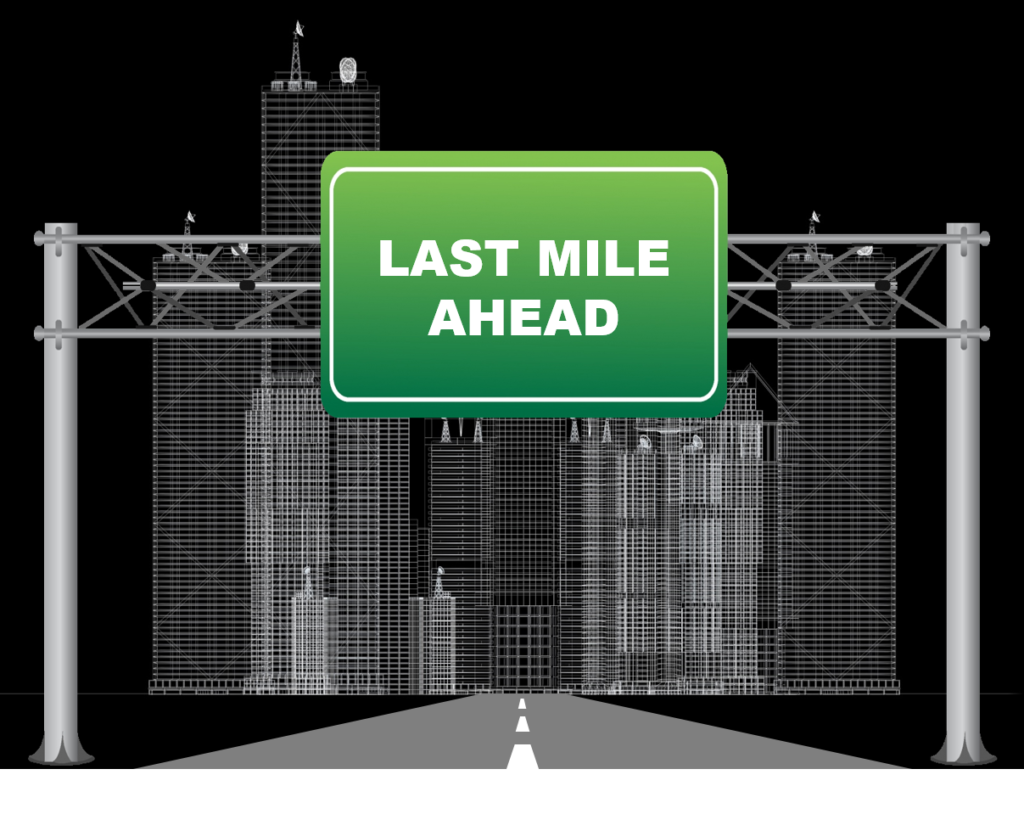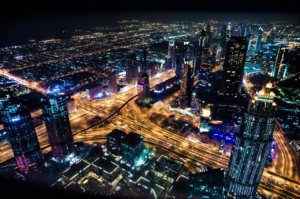City planners around the world are wrestling with how to untangle traffic snarls in inner cities. Their goal is to make cities cleaner and more livable. The picture often painted of the smart city of the future is one featuring clean air and uncrowded streets — thanks to convenient mass transit and an increased number of pedestrian malls. For example, urban planners in Charlotte, NC, have “designated a 60-acre, 50-square block area as a place for modern, urban redesign, dubbed the North Tryon Vision Plan. The plan prioritizes walkable areas, a shrunken complete-streets grid, limited underground parking, play parks, and other small gathering places built for people and not their cars.”[1] Such areas sound idyllic; but, pedestrian only, limited traffic areas could create logistics challenges. A topic seldom raised in smart cities discussions is last-mile logistics (i.e., getting the goods required by urban residents into the stores where they shop or delivered to the buildings where they live). Cities failing to master the last-mile logistics challenge will never earn the “smart cities” label.
Last-mile Logistics in the Smart City
The problem with many traffic-reducing or traffic-elimination urban schemes is that they create unintended challenges (e.g., how to deal with garbage collection, deliveries, parking, etc.). Since city fathers generally don’t have the luxury of planning from the ground up, they must deal with things as they have evolved. Drive through New York City (or any other large, established metropolis) on any given work day and you will find dozens of delivery vehicles double parked as suppliers try to replenish the shelves of retailers so they can meet the needs of their urban customers. The need to supply retailers or deliver packages to residences won’t go away simply because planners want to fill cities with generous numbers of auto-free streets and/or with greenways reserved for pedestrians and bicycles. When transportation is discussed, it often focuses on moving people rather than goods. We can’t put all of the blame on city planners and politicians. George Prest (@mhi_ceo), CEO of MHI, reports, “MHI’s Annual Industry Report, ‘Next-Generation Supply Chains: Digital, On-Demand and Always-On,’ [found] a full 50% of the 1,100 manufacturing and supply chain industry leaders surveyed are not aware of Smart City Logistics.”[2] If logistics leaders don’t have smart city logistics on their minds, you can’t expect city planners to be focused on the subject either.
“While pie-in-the-sky dreams of utopian smart cities fill the media waves,” writes Chad Prevost (@ChadPrevost), “[what does a smart city] mean for commercial transportation and the supply chain?”[3] To answer that question, he interviewed Gerry Mead, executive director of innovation for Phillips Industries. Mead told Prevost, “To me the first step and most important is cooperation.” Too often, planners fail to consult with all stakeholders or ignore potential challenges because they clash with pre-determined goals. Ignorance is never bliss. This is especially true in the area of logistics. Prest explains, “To create and achieve the objectives of a Smart City Logistics strategy, a company or a municipality simply cannot go it alone. There are too many factors, data points and stakeholders intertwined within this unique challenge. Rather, the smartest strategy is to build collaborations between city government, multiple businesses (including competitors), academia, environmental organizations, transportation operators, independent researchers, consultants and more.”
Collaboration, Connectivity, and Urban Last Mile Logistics
Deborah Abrams Kaplan (@KaplanInk) reports, “Urban freight is expected to increase 40% by 2050, going hand-in-hand with the slew of retail stores closing due to e-commerce growth. That means more trucks on the road, clogging precious residential and downtown street space while making deliveries.”[4] Not only does an increase in truck traffic disproportionately increase traffic congestion, it adds to air pollution. Kaplan explains, “Truck congestion is a burden, but too much traffic also affects air quality. As a result, improving air quality is often a goal in cities’ last mile planning process. … It’s estimated that 25% of carbon dioxide emissions and 30-50% of other pollutants are caused by urban freight transported by diesel-powered trucks.” The growing electric vehicle trend will help with the pollution problem, but not the congestion problem. Consolidating goods on to fewer vehicles could help with the congestion problem, but freight consolidation creates other challenges requiring even greater collaboration between competitors. She concludes, “If the last mile is to be perfected, city planners, carriers and retailers must do their part to work together.”
Many planners, both commercial and public, are relying on greater connectivity to help mitigate the urban last mile challenge. With greater connectivity, Mead asserts, “Smart cities could reroute traffic to alleviate congestion thus helping trucking hotspots. Think of closing down and opening lanes based on traffic volume. Automatically rerouting to help save people time, thus saving them money. Data could be used by both shippers and receivers to look at the very intelligent traffic systems and change their shipping or receiving times to help alleviate issues even more. City-by-city evaluation that gets smarter through e-learning as data is added. Systems that can even connect into trucking companies routing systems to help them select even smarter routes to help capture back their valuable assets availability times.” Vehicles connected to each other, to smart infrastructure, and to transportation management systems could have a big impact on how cities deal with last mile logistics. At the end of the day, however, delivery vehicles still need a place to deliver goods efficiently. Every aspect of urban logistics needs to be considered from entry to delivery to exit. There are no silver bullet solutions; but, collaboration and connectivity will help create more efficient smart city logistics processes.
Summary
If nothing is done to address smart city logistics, the U.S. Department of Transportation (USDOT) predicts, “By 2040, nearly 30,000 miles of our busiest highways will be clogged on a daily basis.”[5] And traffic congestion costs money. The USDOT notes, “Truck congestion wastes $27 billion in time and fuel annually.” Those costs are eventually born by consumers. If urban planners want healthier and congestion-free urban streets, they have to tackle the last mile logistics challenge. Prevost concludes, “As urban areas continue to expand and grow, smart city technology will continue to expand as well. Generally speaking, the ideas focus on sustainability and efficiency to better serve humanity as a whole. By leveraging pervasive connectivity, open data, end-to-end security and software monetization solutions, we can align evolving smart city needs for a greatly improved experience for all partners in the supply chain.”
Footnotes
[1] Daniel J. McGraw, “Charlotte Moves toward a Car-Free City Center,” Next City, 30 July 2018.
[2] George Prest, “The New Era of Smart City Logistics,” Inbound Logistics, 18 November 2017.
[3] Chad Prevost, “How smart cities will improve trucking and the supply chain,” FreightWaves, 13 August 2018.
[4] Deborah Abrams Kaplan, “How cities can help supply chains perfect the last mile,” Supply Chain Dive, 22 May 2017.
[5] U.S. Department of Transportation, “Smart City Challenge: Urban Freight Delivery and Logistics,” Transportation.gov, 6 January 2016.





